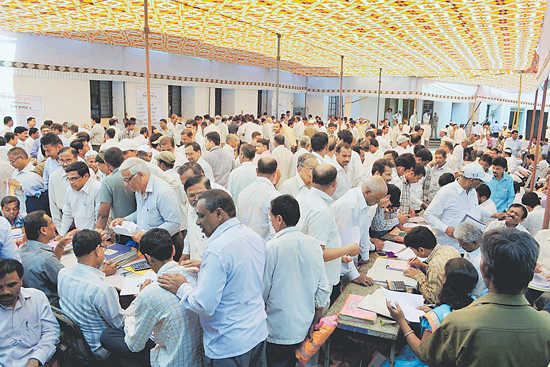
Plaintiffs at the National Lok Adalat on the district court premises in Karad, Maharashtra. (Below) The CJI, TS Thakur. PTI
Dammu Ramakrishnaiah
A few months back, the Chief Justice of India, T.S. Thakur famously broke down as he lamented that the judiciary has been made a scapegoat for increasing the pendency of cases which are more than 3 crore in the entire country. He stated that the present judicial strength of 18,000 cannot dispose of over 3 crore cases. Also, while the Law Commission had sought 40,000 judges in 1947 and recommended a ratio of 50 judges for a population of 1 million, the present judge to people ratio is abnormally low at 15 judges to a million people. Moreover, the country’s population has increased by 25 crore since then.
The CJI conceded that the mounting delay in filling up of vacancies was mostly on account of the confrontation between the government and the judiciary as to who should have primacy in the appointment of judges to the Supreme Court and high courts. While these observations by the CJI are right, one has to also look into the reasons for the confrontation. Unfortunately, in this country everyone wants power and nobody wants to let go the privileges of power. The important question that nobody seems to be bothered about or answer is that why should the government or collegium have any power in the appointments to the judiciary? Both the government and judiciary should discharge their duties impartially and neutrally. Appointments can easily be left to the domain of an independent body which need not be influenced either by the government or the judiciary. Unfortunately, neither the government nor the judiciary is keen to have such a body because neither of them wants to let go their say in judicial appointments. In our society, people and those managing institutions want rights but not so much the responsibility. The privileged positions are often garnered, captured by privileged people of influence. These privileged people like to perpetuate their fiefdoms — be it appointments to judiciary or continuation of political legacies such as sons of prominent politicians becoming MLAs, MPs or even chief ministers or for that matter even in sports associations and federations. In Bollywood too, star kids have it much easier than the other struggling ones. Everywhere the story is the same — continuation of privileges while paying lip service to transparency.
Prior to the collegium system attaining control over the judicial appointments, judiciary had also demanded the introduction of the All-India Judicial Services. This demand has been raised in the Parliament and in several quarters since the last five decades. Interestingly, ever since the collegium attained power in the appointments to the judiciary, it no longer talked about the introduction of the All-India Judicial Services. Rather at every opportunity, the proposal was struck down by both the judiciary and the state governments as they now found a very convenient way to surreptitiously push in their candidates.
Why would state governments and high courts repeatedly refuse the introduction of the All-India Judicial Services? It defies any logical explanation especially when an All-India Judicial Services introduces transparency and objectivity, while ensuring neutral appointments. Above all, it attract the brightest of the talent from all parts of the country. The All-India Judicial Services was never made to see the light of the day as its introduction would reduce any scope for judicial or executive intervention in the appointments to the judiciary in the high courts and Supreme Court. The current impasse on account of the National Judicial Appointments Commission can only be seen as a tug of war between the executive and the judiciary.
Over the last two decades, the judiciary has been having far too much say in the judicial appointments and the executive seems to be having a problem with that. A survey needs to be done in the appointments of the judges to the high courts and the Supreme Court over the last couple of decades so as to ascertain how many judges with familial links in the judiciary and the political elite were appointed. Nobody knows the truth, but it's often spoken in whispers that a significant number of kith and kin of a few judicial and political families have found their way as far as higher judicial appointments go.
Is this desire on the part of the judiciary to perpetuate nepotism and favouritism that is stalling the five- decade-old demand for introduction of the All-India Judicial Services? The delay in the introduction of this service is a grave injustice to the lakhs of students enrolled as law students and aspiring to become judges.
Currently, the most brilliant of law students can only aspire to become judges of the lower-level judiciary. For them the gates of the high courts and the Supreme Court are almost closed. It is pertinent to mention that most of the judicial appointments in the high courts are entirely made from the lawyers’ category and they do not write any examination. Are they nominated on the basis of professional competence, integrity or sycophancy, favouritism or nepotism? One needs to know.
The secrecy of the judicial appointments was compounded by the fact that the judiciary has never been under scrutiny. It is outside the purview of the CVC and the CBI. It's a closed door thing and the only way to remove a judge is through the mechanism of impeachment. With divided Parliaments that we have been witnessing since 1989, this aspect has almost been a non-starter, giving rise to unfettered freedom of operation and arrogance to the judiciary. The need to fill up of vacancies in the high courts and the Supreme Court has to be seen against this background. There is no denying that it is necessary to fill up vacancies. But they need to be filled up in a transparent, non partisan manner devoid of nepotism and favouritism. What else can be better than the introduction of the All-India Judicial Services, that the Article 311 provides for. Candidates selected by an independent body such as the UPSC, can be professionally trained and be appointed directly through a well-laid out and transparent system.
The writer, a retired IAS officer, is a former Vice Chancellor of Osmania University.



























